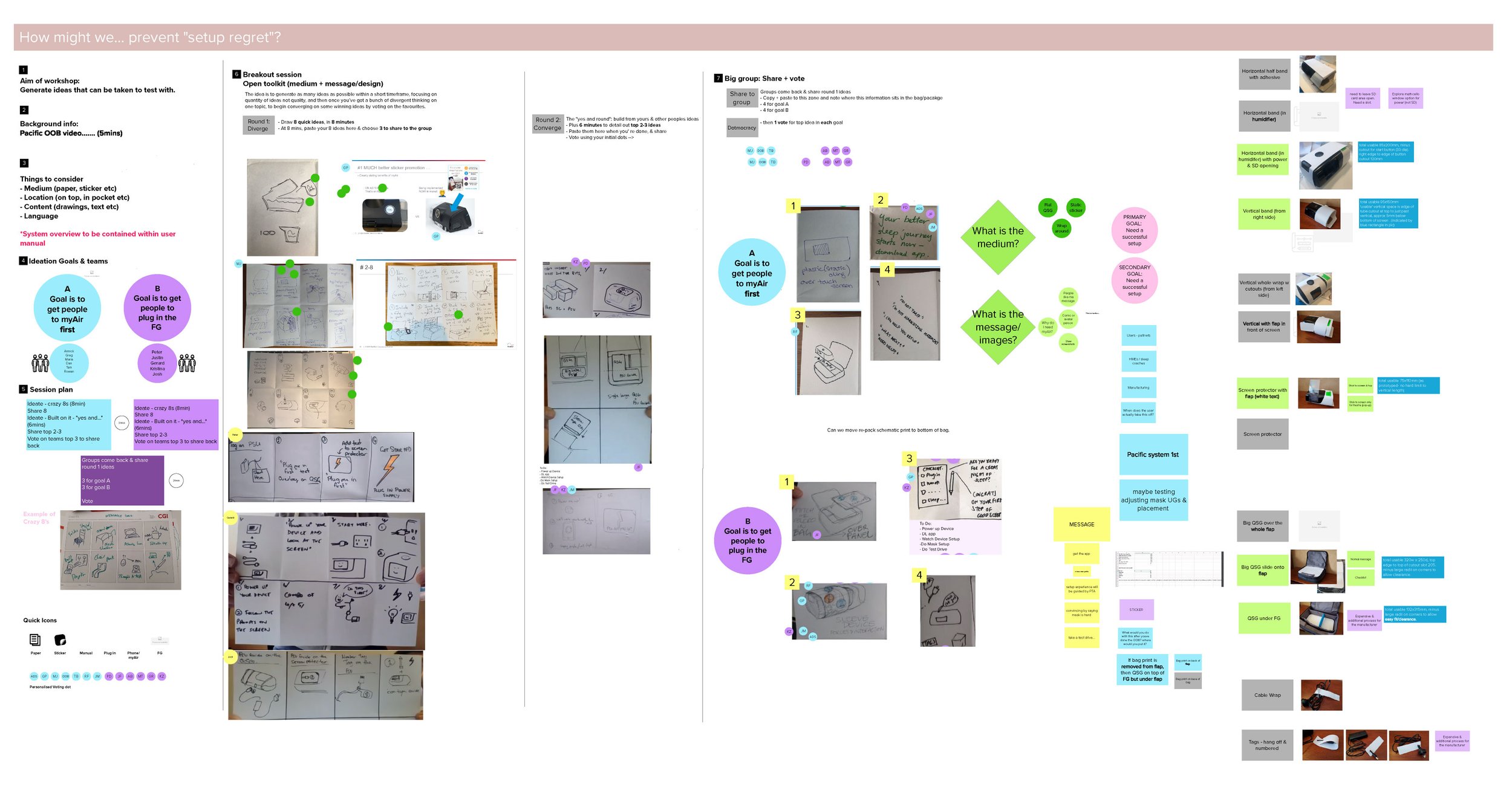
Out of box experience
AirSense 11
Users expect one system.
Not a collection of independently designed products.

IMPROVED SETUP EXPERIENCE
One of the platform goals of AirSense 11 was to improve the setup and acclimatisation experience of CPAP therapy. Personal Therapy Assistant (PTA) is a feature developed on the myAir app which guides users through device & mask setup and gives them a gentle introduction to pressure and therapy. Through user testing, we proved users were more confident and comfortable in starting therapy when they used PTA as part of their setup.
Our goal then for AirSense 11’s OOBX was to drive as many users to setup with the myAir app.
INITIAL OOBX TESTING
During our first end-to-end setup user testing of the AirSense 11, we discovered two main issues:
Almost no users opted to download myAir initially. Most attempted to set up AirSense 11 system by themselves before getting stuck and then turning to myAir. This told us that the Quick Start Guide (QSG) was not convincing enough in its messaging.
We also discovered that users we’re getting confused with the multiple guides and instructions (QSG, AirSense 11 user guide, mask user guide).
SETUP REGRET
In testing the end-to-end experience, we found that many users experienced what we coined ‘setup regret’. Users wished they had downloaded the myAir app to help them set up but only after attempting it themselves and getting stuck. It was only once they were in the app that they realised its value in setting up the AirSense 11 system.

THE CHALLENGE
Eliminate ‘setup regret’
Drive more users to to set up with the myAir app by communicating that as the primary instruction.
Provide a non-competing system schematic (non-app set up) for those users who can’t or won’t download the app
THE MEDIUM
The Quick Start Guide
CONSIDERATIONS
In order to come up with new QSG designs to test we had to consider multiple aspects.
Learnings from initial testing
Understanding what value exchange users were looking for in order for download the app. e.g. video content.
Understanding line assembly requirements
Interfacing with manufacturing teams to ensure the design wouldn’t cause any intricate packing procedures or add too much time on the line assembly.
Form & location
Widening the possibilities of the form the QSG could take and where it could sit within the bag.
Consider costs
Working with the ID and GSA teams to ensure no design would add too much additional cost to the project.
Manage languages
In past platforms, QSG’s were language-less. In order to convey the value of downloading myAir for set up, we knew that pictures and images alone would not work. Taking that into account we needed to consider that there would be at least 4 languages on each QSG variant for every region globally.
Clinician workflows
The design needed to be unobtrusive to clinical set up workflows. If the design got in the way there was a risk it would be misplaced, or worse, completely removed from the bag.

THE DESIGNS
In total we brought five designs to the next round of testing. Some were a combination of QSG and schematic. Others purely QSG with schematic in the User Guide.
THE METHOD
During user testing each participant was given a bag with one of the QSG’s. Once it was clear how they intended to set up (myAir vs manual) we halted the test. From there we asked questions about what helped them make their decision. We then proceeded to show them the remaining QSG designs to get feedback.

THE RESULTS
QSG 1a/1b were the most preferred- in terms of hierarchy of information, this made the most sense to people as the place for the primary setup message.
QSG under the device (3) was generally the least preferred – same point as above regarding hierarchy of information: ‘hiding’ it under the device didn’t make sense to most people.
Overall across all QSG’s we saw a 23% increase in users opting to download myAir (compared to initial testing) before attempting to set up the system themselves.
3/6 users who had QSG 1a reversed their decision to download myAir once they turned over the QSG and saw the schematic on the back.
On top of these learnings we learnt that the prospect of an app is more compelling if it offers more than just setup help:
The value of an app for some is how to set it up & use it correctly, rather than just assembly.
Being able to track sleep going forward was suggested by several users as something that would make the app more worthwhile (without any prior knowledge of myAir).
“I still prefer the one with the big flat instruction. You can’t get much clearer than that”
— Participant 3
“underneath the machine…suggested to me that’s an optional thing. I can still probably set up the machine without it”
— Participant 7

Final design
This QSG design was released with AirSense 11
and to date has increased myAir
adoption at setup by 35%.






